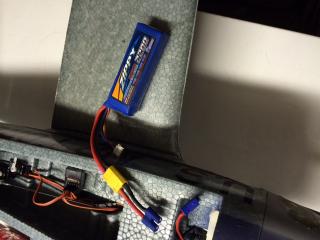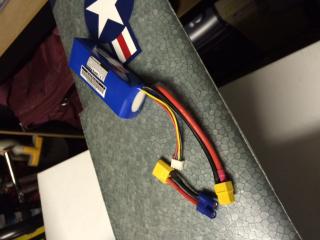(29-12-2014, 07:51 PM)robbo Wrote: What I understand is the 25C is the max the battery can supply in a burst (in theory) ie 25 x 2.2Ah = 55A right?
Unfortunately, there are no applicable measurement standards, which makes the C-ratings printed on labels practically meaningless. Every manufacturer is free to apply their own criteria, and they do so, liberally. At best, the label C-rating serves as an indication of how the manufacturer would like their various product lines to be stack-ranked against each other ("40C has got to be better than 35C, surely?!?").
Let's say we call the "true" C-rating that which can be delivered from full to empty (20% remaining) without sustaining damage in the process. Virtually all new lipo cells have true ratings ranging from 20C to 25C. Exceptional cells might creep up toward 27C, 28C, or even 30C, but it's vanishingly rare.
Lithium polymer chemistry is capable of dissipating around 6 watts per amp-hour of capacity, as heat, before internal temperature rises beyond the "venting" threshold where the cell is visibly puffed up. Obviously, ambient temperature and the amount of colling air flowing around the cell also play a part, but everything else being equal the magic formula is Pmax=6W/1aH.
For a 2200mAh cell, it thus follows that 13.2 watts is the maximum safe power dissipation. P=IV, V=IR, so we can express power in terms of current and resistance as P=I(IR), or rather P=I^2R. In other words, the greater the internal resistance, the less current a cell can take without damage. Internal resistance is therefore the true measure of quality and performance.
It takes a somewhat fancy charger (iCharger line, Powerlab) or a dedicated device to measure cell internal resistance with any significant level of accuracy. Once the resistance is known, it becomes simple to calculate the "true" C-rating using the formulas above.
All labels which read "35C" or more are highly questionable, since nothing of the sort exists yet. The manufacturer first established what number they wanted to print on the label in order to keep up with their competitors, and then worked backwards to establish arbitrary test standards which justify the number. Note that the actual test procedures are _never_ published. We are supposed to take it on faith that this one is a "65C" battery, or even higher, even though the currents involved would destroy the cell within one or two such iterations, or melt the copper wires which are meant to be delivering "65C".
(29-12-2014, 07:51 PM)robbo Wrote: As battery performance will deteriorate over time, and that 'C' rating will decline...
Yes. To some extent that degradation is inevitable, although keeping cells fully charged hastens the process. Internal resistance increases at an exponential rate once the cell voltage is over 4.0V, which is why it pays to be dilligent about "storage" charging after a day's flying rather than keeping lipos full during the week.
It doesn't matter so much with a Trojan since it sucks relatively low current. Even a drop in "true C" from 25C to 20C over say a year will not be felt since the motor pulls like 10C tops.
It matters much more in high-current applications such as pylon racers and 3D helis. A powerful helicopter can easily pull 20C sustained, and it starts making more sense to invest in better batteries (Pulse, Gens Ace, Thunder Power...). Of course, they must not be kept fully charged, or their performance will quickly come back down to "true" ~20C, whatever marketing fantasy might be printed on the label.
Incidentally, there's no such thing as a C-rating which is too high. The motor+ESC combo is doing the pulling - there is no pushing on the battery's part. If it existed (which it doesn't!), it would be entirely safe to put a "65C" (true) pack in a Trojan.
(29-12-2014, 08:51 PM)robbo Wrote: Oh I also changed the connector on the trojan to XT60, I just figure I may as well standardise on a single connector type across all planes and batteries I get.
Yep, connector standardisation is a good idea. It saves weight, decreases resistance and complexity, and thereby lessens the chances of something going wrong while one is absent-mindedly plugging stuff in while yacking with others down at the field.
Besides, soldering is fun, and very difficult to avoid in this hobby













 .
.